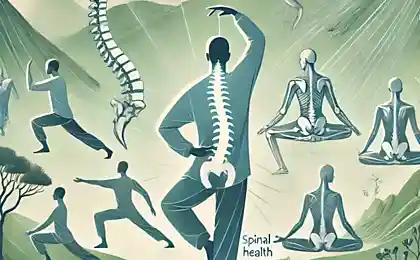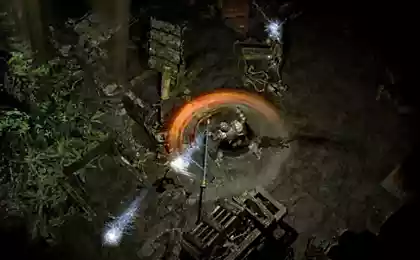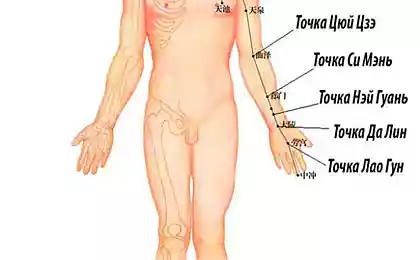373
Remove tissue congestion: how to roll out on the roller
Roll out or not? That is the question! What happens inside the body when you use the rolling on the roller, massage balls or other equipment for self-myofascial release (SMFR)?
For beginners: you will not be able to roll on the roller exclusively by only one fascia. All other cells: nerves, muscle, epithelium also affected.
In muscle and epithelial tissues water is squeezed out of the tissue and is naturally absorbed back with the disappearance or reduction of pressure.
Just as we squeeze the sponge for washing dishes, and then allow it to absorb water again, scrubbing pans and pots. As says an old Bedouin proverb: "still water is poison! Moving water is the life!"
Or, as the famous physicist of the 16th century Paracelsus: "There is only one disease, and her name — stagnation".

Roller can certainly help liquefy and disperse this stagnation in the tissues, which you rolled. It does not make the muscle stronger, however, it is obvious that this can improve the elasticity of the arteries to the muscle. If we consider the response of nerves, rolling on the roller might be too "sensitive". Nothing good, if it's so painful that cause muscle contraction and compression of the cells, so I am not a supporter painful rolling. I prefer my clients remain in the comfort zone, or so-called "hedonic point" (balancing between pleasure and pain).
Rolling through the pain, however, can be useful when working with previously injured areas – for example, in the region of the old fracture. But at the same time, I want to leave this area painless, when you are done the roller, without edema, "bruises" and further injury.
In General, the "bruising" and bruises — in my opinion, there is almost always a symptom of a tissue damage, not healing. Slow movement along the roller (or any other type of equipment for release) is extremely important in the painful area.
In summary, I can add that we use the unrolling on a roller to "Wake" region "Sensorimotor Amnesia" – to bring "sensory experience" in those places in the body in which you (or your client) usually there is no movement in everyday life.
I will say two things about it:
1) Your ilio-tibial tract (PBT) is not a place where there is sensory-motor amnesia. He "towers over the rest of the world" and so stimulated every day. Some of the most probable area "sensory-motor amnesia" (SMA) are hard to find and the more "roll" – like a quadrant adductors on the inner thighs, and hard - accessible and a tiny (but important) area of the deep lateral rotators on the back of the thigh or directly under your head at the top of the neck.
2) We tend to ignore our own region of the AGR for a very simple reason that you can't feel them and so we don't know where they are. Here we can help our clients, making sure that they rolled out those areas that really need rolling, rolling resistant is the most accessible and obvious areas, such as PBT or superficial muscles of the back.
In practice, instead of rolling out the gluteus Maximus, or easily accessible part of the PBT, then try installing the roller or other equipment from under the edge of the iliac crest (near its distal or lower region, right at the top of the buttocks). directly under (the iliac crest) and roll down in the direction of the bone at 2-3 cm Work along the whole crest, iliac spine (eng. ASIS) to posterior superior iliac spine spine (eng. PSIS).
This area is often neglected both in manual and in the WWE will bring results, new sensations, hydration. Or work on the other end PBT, placing the working surface of the roller below the knee, just between the end of the PBT on myselt of the tibia and head of fibula. Work slowly in this area by a slight rotation of the foot during rolling on the roller. It can help to clear the head of the fibula so she could participate in the rotational movements during sports, especially in sports like tennis or football, where you rotate around the supporting leg. Total, you can use a roller and other equipment in order to restore sensitivity, but many people ask me about the effect of rolling on the roller for the fascia, as it is often advertised as a benefit of such an event.
At the risk of insulting some, I will say the following:
Every time I go to the gym, there is always someone on the Mat in the corner, rolling your PBT with a grimace of pain on his face. This work is, to put it mildly, is not useful. Large heavy arrays fascia – PBT, thoracic fascia, plantar fascia – can't be "extended" by the rolling roller, so please don't tell your customers or at least to dissuade yourself first.
"Rolled out" stop, of course, you may feel better, seem more "alive" and can even decrease inflammation (though often only temporarily), but if we stop on this go through thousands of steps a day, and she still has not lengthened, then a few rolling on a roller, much less be able to cause this effect.
You can increase hydration, proprioception, and perhaps even "melt" the fascial connection at the edges, providing greater freedom of movement. But if you try to apply pressure which is required to obtain significant changes on the entire length of the fascia, then your customer with a loud cry will flee from you out the door. It's simple math, not someone's opinion.
Secondly, I do not understand and do not feel any benefit in retaining a single point over a long period of time, unless it is the acupuncture point or tsubo therapy, in which you need prolonged exposure to improve energy flow. In most cases, slow motion is better than static pressure.
There is a sense to put pressure on a trigger point, as long as this pressure is aimed at "sensitive heart" problem the clamped zone), but in this case, if pressure is applied at the right spot, then 20-30 seconds max is enough for hydration of the tissues and dispersion of the most trigger points. "Push" more – to influence more precisely – the best way!
Thirdly, the pressure point will not necessarily create the necessary "unstuck" the force required to break a "sticking" fascial layers – what is the most common cause of restriction of movement. To separate, for example, PBT from epimysial broad lateral muscles, the rolling is completely useless. If the surface of the roller is quite "clingy" you can nail him to the floor with your hand or pin blocks (or use a half-cylinder), and then move the body through it again, slowly and carefully. It can create a burning sensation, like a burn from an Indian rope that you threw your big brother, but it is burning means putting up two fascial layers. Keep a slow speed to keep the feeling within certain limits.
With increasing practice, you can achieve such "pasting" between the skin and placed underneath the muscles, or muscle groups, or between layers of a multilayer fascia such as thoracic. The main point is missed when "rolling" the roller needs to remain stationary while the body moves across the roller to achieve significant effect of "pasting". Now, of course, as a chiropractor with experience more than 40 years, I appreciate how "knowledgeable experienced hands" applied to the unknown object, is a great tool for changing body inside.
I can create the effect of "pasting" by the location of the client and adjusting the degree of pressure of my constantly monitoring this degree via sensory feedback, thus I'm better than the roller I can see, and find "secret places" with great tension, which people don't even know and can "awaken" or relax them. I see the whole image and give the option of treatment that progressively releases it snapping and "gluing" in an integrated way. I can feel the moment when "food is ready" and work in this region over. But not everyone can afford to do personally with the therapist, so the equipment MFR is fairly inexpensive and a good way to obtain the above described effects. And if you are self-MFR, the following tips for you:
1. Move slowly. Fast rolling is less effective for compression sponges" and could lead to the creation of useless muscle tension, swelling, and damage to receptors. The deeper you dig, the more slowly you must progress.
2. Search for 'places' in the body. The execution of the same program rolling out with the roller only reduces the effectiveness of this procedure. Continue to "roll out" different places in the body and look for ones that you haven't touched and work there. For example, you lie on your side, and unroll the inner surface of the upper thigh, or try to roll the front and back armpit. Your back has lots of muscle layers and can be helpful to roll it on deeper levels, rather than having to run all the time "the good old rolling back".
3. Hold the roller or other equipment stationary and move along it to create a "posting" fascial layers. So, roll out or not? In response to paraphrase hamlet: “For there is nothing either good or bad, but thinking makes it so”. Conscious, slow, controlled rolling is much more useful than painful rolling, running fast, along the way, focused on reading, music and watching pretty woman at the other end of the hall. published
Author: Thomas Myers (Dmitry Semenov)
P. S. And remember, only by changing their consumption — together we change the world! ©
Join us in Facebook , Vkontakte, Odnoklassniki
Source: vk.com/wall-23903469?w=wall-23903469_9643%2Fall
For beginners: you will not be able to roll on the roller exclusively by only one fascia. All other cells: nerves, muscle, epithelium also affected.
In muscle and epithelial tissues water is squeezed out of the tissue and is naturally absorbed back with the disappearance or reduction of pressure.
Just as we squeeze the sponge for washing dishes, and then allow it to absorb water again, scrubbing pans and pots. As says an old Bedouin proverb: "still water is poison! Moving water is the life!"
Or, as the famous physicist of the 16th century Paracelsus: "There is only one disease, and her name — stagnation".

Roller can certainly help liquefy and disperse this stagnation in the tissues, which you rolled. It does not make the muscle stronger, however, it is obvious that this can improve the elasticity of the arteries to the muscle. If we consider the response of nerves, rolling on the roller might be too "sensitive". Nothing good, if it's so painful that cause muscle contraction and compression of the cells, so I am not a supporter painful rolling. I prefer my clients remain in the comfort zone, or so-called "hedonic point" (balancing between pleasure and pain).
Rolling through the pain, however, can be useful when working with previously injured areas – for example, in the region of the old fracture. But at the same time, I want to leave this area painless, when you are done the roller, without edema, "bruises" and further injury.
In General, the "bruising" and bruises — in my opinion, there is almost always a symptom of a tissue damage, not healing. Slow movement along the roller (or any other type of equipment for release) is extremely important in the painful area.
In summary, I can add that we use the unrolling on a roller to "Wake" region "Sensorimotor Amnesia" – to bring "sensory experience" in those places in the body in which you (or your client) usually there is no movement in everyday life.
I will say two things about it:
1) Your ilio-tibial tract (PBT) is not a place where there is sensory-motor amnesia. He "towers over the rest of the world" and so stimulated every day. Some of the most probable area "sensory-motor amnesia" (SMA) are hard to find and the more "roll" – like a quadrant adductors on the inner thighs, and hard - accessible and a tiny (but important) area of the deep lateral rotators on the back of the thigh or directly under your head at the top of the neck.
2) We tend to ignore our own region of the AGR for a very simple reason that you can't feel them and so we don't know where they are. Here we can help our clients, making sure that they rolled out those areas that really need rolling, rolling resistant is the most accessible and obvious areas, such as PBT or superficial muscles of the back.
In practice, instead of rolling out the gluteus Maximus, or easily accessible part of the PBT, then try installing the roller or other equipment from under the edge of the iliac crest (near its distal or lower region, right at the top of the buttocks). directly under (the iliac crest) and roll down in the direction of the bone at 2-3 cm Work along the whole crest, iliac spine (eng. ASIS) to posterior superior iliac spine spine (eng. PSIS).
This area is often neglected both in manual and in the WWE will bring results, new sensations, hydration. Or work on the other end PBT, placing the working surface of the roller below the knee, just between the end of the PBT on myselt of the tibia and head of fibula. Work slowly in this area by a slight rotation of the foot during rolling on the roller. It can help to clear the head of the fibula so she could participate in the rotational movements during sports, especially in sports like tennis or football, where you rotate around the supporting leg. Total, you can use a roller and other equipment in order to restore sensitivity, but many people ask me about the effect of rolling on the roller for the fascia, as it is often advertised as a benefit of such an event.
At the risk of insulting some, I will say the following:
Every time I go to the gym, there is always someone on the Mat in the corner, rolling your PBT with a grimace of pain on his face. This work is, to put it mildly, is not useful. Large heavy arrays fascia – PBT, thoracic fascia, plantar fascia – can't be "extended" by the rolling roller, so please don't tell your customers or at least to dissuade yourself first.
"Rolled out" stop, of course, you may feel better, seem more "alive" and can even decrease inflammation (though often only temporarily), but if we stop on this go through thousands of steps a day, and she still has not lengthened, then a few rolling on a roller, much less be able to cause this effect.
You can increase hydration, proprioception, and perhaps even "melt" the fascial connection at the edges, providing greater freedom of movement. But if you try to apply pressure which is required to obtain significant changes on the entire length of the fascia, then your customer with a loud cry will flee from you out the door. It's simple math, not someone's opinion.
Secondly, I do not understand and do not feel any benefit in retaining a single point over a long period of time, unless it is the acupuncture point or tsubo therapy, in which you need prolonged exposure to improve energy flow. In most cases, slow motion is better than static pressure.
There is a sense to put pressure on a trigger point, as long as this pressure is aimed at "sensitive heart" problem the clamped zone), but in this case, if pressure is applied at the right spot, then 20-30 seconds max is enough for hydration of the tissues and dispersion of the most trigger points. "Push" more – to influence more precisely – the best way!
Thirdly, the pressure point will not necessarily create the necessary "unstuck" the force required to break a "sticking" fascial layers – what is the most common cause of restriction of movement. To separate, for example, PBT from epimysial broad lateral muscles, the rolling is completely useless. If the surface of the roller is quite "clingy" you can nail him to the floor with your hand or pin blocks (or use a half-cylinder), and then move the body through it again, slowly and carefully. It can create a burning sensation, like a burn from an Indian rope that you threw your big brother, but it is burning means putting up two fascial layers. Keep a slow speed to keep the feeling within certain limits.
With increasing practice, you can achieve such "pasting" between the skin and placed underneath the muscles, or muscle groups, or between layers of a multilayer fascia such as thoracic. The main point is missed when "rolling" the roller needs to remain stationary while the body moves across the roller to achieve significant effect of "pasting". Now, of course, as a chiropractor with experience more than 40 years, I appreciate how "knowledgeable experienced hands" applied to the unknown object, is a great tool for changing body inside.
I can create the effect of "pasting" by the location of the client and adjusting the degree of pressure of my constantly monitoring this degree via sensory feedback, thus I'm better than the roller I can see, and find "secret places" with great tension, which people don't even know and can "awaken" or relax them. I see the whole image and give the option of treatment that progressively releases it snapping and "gluing" in an integrated way. I can feel the moment when "food is ready" and work in this region over. But not everyone can afford to do personally with the therapist, so the equipment MFR is fairly inexpensive and a good way to obtain the above described effects. And if you are self-MFR, the following tips for you:
1. Move slowly. Fast rolling is less effective for compression sponges" and could lead to the creation of useless muscle tension, swelling, and damage to receptors. The deeper you dig, the more slowly you must progress.
2. Search for 'places' in the body. The execution of the same program rolling out with the roller only reduces the effectiveness of this procedure. Continue to "roll out" different places in the body and look for ones that you haven't touched and work there. For example, you lie on your side, and unroll the inner surface of the upper thigh, or try to roll the front and back armpit. Your back has lots of muscle layers and can be helpful to roll it on deeper levels, rather than having to run all the time "the good old rolling back".
3. Hold the roller or other equipment stationary and move along it to create a "posting" fascial layers. So, roll out or not? In response to paraphrase hamlet: “For there is nothing either good or bad, but thinking makes it so”. Conscious, slow, controlled rolling is much more useful than painful rolling, running fast, along the way, focused on reading, music and watching pretty woman at the other end of the hall. published
Author: Thomas Myers (Dmitry Semenov)
P. S. And remember, only by changing their consumption — together we change the world! ©
Join us in Facebook , Vkontakte, Odnoklassniki
Source: vk.com/wall-23903469?w=wall-23903469_9643%2Fall























